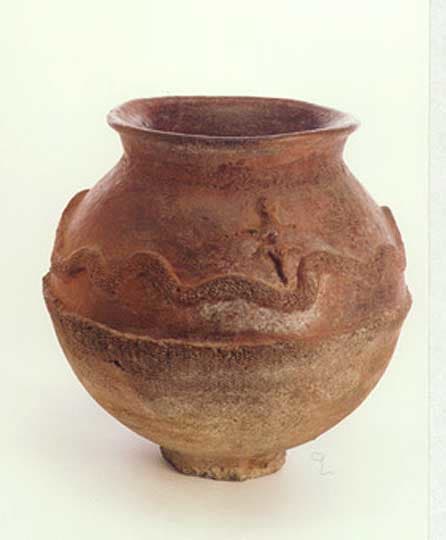Djenne Terracotta Vessel, 12th Century CE - 15th Century CE
Terracotta
13.75 x 14.5
PF.4522
Removed from the alluvial soil of the Niger delta, between the cities of Segou and Timbuktu, extraordinary statues and pottery came into the light that have few parallels in the...
Removed from the alluvial soil of the Niger delta, between the cities of Segou and Timbuktu, extraordinary statues and pottery came into the light that have few parallels in the world. To understand the pottery, such as this exquisite example, we should first examine the statuary. They depict individuals in a seated position with hands on their knees. Their eyes are either squinting or bulging; in either case giving the impression of someone in a trance. The most amazing feature is there are snakes everywhere, climbing up their backs, appearing from orifices, noses and ears, with one extraordinary example of a woman giving birth to a snake. The implication is that these statues are part of a very ancient snake cult which flourished in certain regions. The figures may be priests who are in a drug induced trance and the snakes represent those which crawled over his body, as they still do in various parts of India today. It is conceivable this vessel was part of a snake-priest's ritual paraphernalia and large enough to have contained a number of serpents!
Circling the vessel is a long and graceful snake, twisting and turning in a very beautiful pattern. It's positioning at the upper portion gives the lower portion greater depth and dimension. The entire object is both delicate and massive at once. Almost primordial, it seems to have 'grown' from the earth, like an exotic plant or flower blooming in the desert, with creatures of the soil, snake and lizard, delicately gracing its body. Snakes were, and are still, believed to be messengers of spirits and deities. This beautiful vessel sends a clear message from a mysterious land and a mystical cult, which somehow connects with something very human and elemental in all of us.
Circling the vessel is a long and graceful snake, twisting and turning in a very beautiful pattern. It's positioning at the upper portion gives the lower portion greater depth and dimension. The entire object is both delicate and massive at once. Almost primordial, it seems to have 'grown' from the earth, like an exotic plant or flower blooming in the desert, with creatures of the soil, snake and lizard, delicately gracing its body. Snakes were, and are still, believed to be messengers of spirits and deities. This beautiful vessel sends a clear message from a mysterious land and a mystical cult, which somehow connects with something very human and elemental in all of us.



